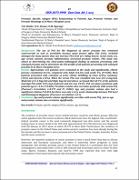Prostatic Specific Antigen (PSA) Relationship to Patient Age, Prostate Volume and Prostate Histology at St. Mary’s Hospital Lacor,

View/
Date
2014Author
Okello, Tom Richard
Alema, N. O
Ogwang, David Martin
Metadata
Show full item recordAbstract
The use of PSA for the diagnosis of cancer prostate has remained
controversial as well as unreliable because many factors affect PSA levels. Included
amongst the many factors that can increase PSA level are riding bicycle, rectal exam, sex,
age, serum calcium, prostate inflammation, increased prostate volume. This study was
aimed at determining the clinic-patho-radiological finding of patients presenting with
enlarged prostate and to determine the PSA profile of all patients presenting with enlarged
prostate in St. Mary’s Hospital Lacor.
Results: Approximate 135 patients were evaluated in the study and significantly, elderly
persons constituted 64.5%, compared with Adult (34.5%) and youth 1%, (P=0.00). Most
patients presented with retention of urine (30%), dribbling of urine (23%), hesitancy
(16%) and dysuria (13%). When the serum PSA was classified into Low (0.1-2.4ng/ml),
Moderate (2.5-3.9ng/ml) and High 4ng/ml and above, we found that 60.7% of the patients
had high PSA while 9.6% had moderate and low was 29.6%. PSA correlates positively with
patients age (r= 0.24, P=0.005). Prostates volume also correlates positively with serum PSA,
(Pearson’s Correlation r=0.275 and P= 0.002). Age and prostate volume also had a
significant relation P=0.054 but there was only a very weak relationship between PSA level
and Histological diagnosis, (Pearson’s correlation r=0.1).
Conclusion: Age and prostate volume significantly correlate with serum PSA, just as age
and prostate volume also correlates significantly
Collections
- Research Articles [34]
